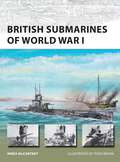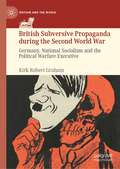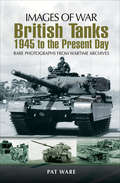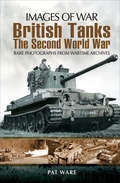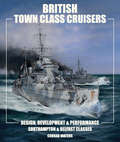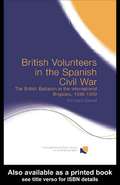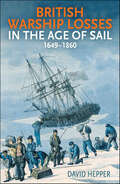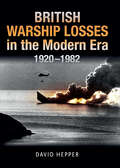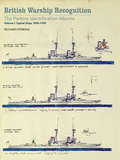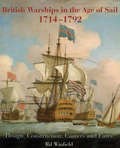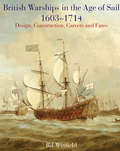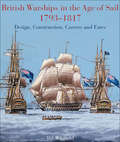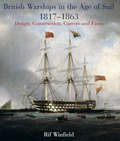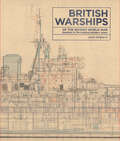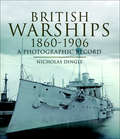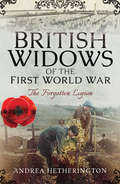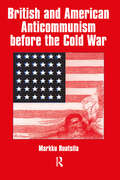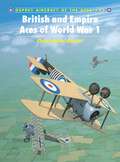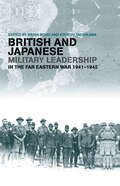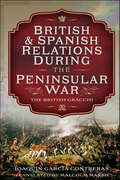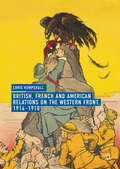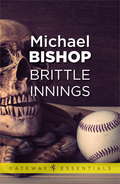- Table View
- List View
British Submarines of World War I
by Tony Bryan Innes MccartneyAs the major powers engaged in an arms race in the early years of the 20th century, the Admiralty was tasked with developing that deadly stalker of the high seas - the submarine. In 1905, briefed with creating a vessel that could be employed on an enemy's coastline, the Admiralty took several technological leaps forward to match Germany's own revolutionary vessels. Written by an influential expert in the field and covering all classes of submarine developed and deployed during the war, this book includes great technical detail, gripping operational accounts and is accompanied by artwork. With fascinating details of daring submarine raids in the Baltic and the Dardanelles, this book reveals the exceedingly dangerous world of early submarine warfare which claimed an extraordinary number of lives on both sides and paved the way for a new kind of naval warfare in the 20th century and beyond.
British Subversive Propaganda during the Second World War: Germany, National Socialism and the Political Warfare Executive (Britain and the World)
by Kirk Robert GrahamThis book offers the first in-depth intellectual and cultural history of British subversive propaganda during the Second World War. Focussing on the Political Warfare Executive (PWE), it tells the story of British efforts to undermine German morale and promote resistance against Nazi hegemony. Staffed by civil servants, journalists, academics and anti-fascist European exiles, PWE oversaw the BBC European Service alongside more than forty unique clandestine radio stations; they maintained a prolific outpouring of subversive leaflets and other printed propaganda; and they trained secret agents in psychological warfare. British policy during the occupation of Germany stemmed in part from the wartime insights and experiences of these propagandists. Rather than analyse military strategy or tactics, British Subversive Propaganda during the Second World War draws on a wealth of archival material from collections in Germany and Britain to develop a critical genealogy of British ideas about Germany and National Socialism. British propagandists invoked discourses around history, morality, psychology, sexuality and religion in order to conceive of an audience susceptible to morale subversion. Revealing much about the contours of mid-century European thought and the origins of our own heavily propagandised world, this book provides unique insights for anyone researching British history, the Second World War, or the fight against fascism.
British Tanks: 1945 To The Present Day (Images of War)
by Pat WareIn this companion volume to British Tanks: The Second World War, Pat Ware provides an expert introduction to the design, production and operation of British tanks since 1945. Fewer types of tank were built than during the wartime period, but the complexity of design and manufacture increased, and a level of technical sophistication in the key areas of armor, firepower and mobility was beyond the imaginings of the tank pioneers of the First World War.Using a selection of contemporary photographs supported by some modern photographs of preserved vehicles Pat Ware sets the modern tank in a historical context. He describes its origins in Britain and its development and deployment in the Second World War and in the post-war period. All the British tanks that have seen service since the war are depicted, among them the Conqueror, Chieftain, Centurion and Challenger. The engineers tanks the flails, recovery vehicles, bridge-layers are featured, as are the less-well-known British tanks made for export.This highly illustrated survey gives a fascinating insight into the recent evolution of the British tank and its role in the postwar world.Pat Ware is a leading expert on the history of military vehicles and a prolific writer of books and articles on every aspect of the subject. His most recent publications include a study of the military Jeep and encyclopaedias of military vehicles and motorcycles. He was the founding editor of Classic Military Vehicle magazine in 2001 and continues to contribute to the magazine as well as writing a military column for Land Rover World.
British Tanks: The Second World War (Images of War)
by Pat WarePerhaps the British did not produce the most successful tanks of the Second World War, but they certainly designed an extraordinary range of light, medium and heavy tanks along with many that were adapted for special purposes. This fascinating variety of military machinery is recorded in Pat Wares photographic history. Using a selection of wartime photographs—supported by some modern photographs of preserved vehicles the book describes the origins of the tank in Britain during the First World War, looks at British tank development during the inter-war period and contrasts this with advances made elsewhere—in Germany, France, the USA and the Soviet Union. All of the British tanks that saw service during the Second World War are described, among them the cruisers (Crusader, Cromwell, Comet), the infantry tanks (Matilda, Valentine, Churchill) and the US imports (Stuart, Lee/Grant, Sherman). Finally, an extensive section is devoted to the so-called funnies'—the tanks developed for crucial tasks like bridge-laying, mine-clearing, flame-throwing and amphibious operation. Pat Wares photographic survey of these tanks at war is an expert introduction to a key period in the history of British fighting vehicles.
British Territorial Units 1914-18
by Mike Chappell Ray WestlakeIn his Army Reforms of 1906/07 the Secretary of State for War, Richard Burdon Haldane, provided for an expeditionary force - the Regular Army supplemented by the old Militia - and a new organisation intended for home defence, the Territorial Force. This new 'Citizen's Army' was formed by the transfer of the Honourable Artillery Company, Imperial Yeomanry and Volunteer Force, all with many years of service and tradition. At the outbreak of World War I, the Territorial Force was organised as per the Regular Army, with infantry battalions, artillery, engineers, supply and medical formations. This title takes a highly detailed and illustrated look at the badges and uniforms and the changing organisation of the British Territorial units during World War I. It also covers the combat experiences of the men who soon found themselves in service overseas, in the thick of the fighting.
British Town Class Cruisers: Design, Development & Performance: Southampton & Belfast Classes
by Conrad WatersThis scholarly study of the Royal Navy&’s WWII light cruisers presents extensive design, performance, and engagement analysis of each ship. When the Second World War began, the ten British &‘Town&’ class cruisers were the most modern vessels of their type in the Royal Navy. Primarily designed for the defense of trade, they played decisive roles in victories such as the Battle of the Barents Sea and the destruction of the German Scharnhorst at the North Cape. They also paid a heavy price: four of the ships were lost and the other six sustained serious damage. In this major study, Conrad Waters provides a technical evaluation of the &‘Town&’ class design and its subsequent performance. He outlines the class&’s origins in the context of inter-war cruiser policy, explains the design and construction process, and describes the characteristics of the resulting ships and how these were adapted in the light of wartime developments. An overview of service focuses on major engagements and presents detailed assessments of action damage. Concluding chapters explore the the modernization program that kept the remaining ships fit for service during the Cold War era. Heavily illustrated with contemporary photographs and expert drawings, British Town Class Cruisers provides a definitive reference to one of the Royal Navy&’s most important warship designs.
British Volunteers in the Spanish Civil War: The British Battalion in the International Brigades, 1936-1939 (Routledge/Canada Blanch Studies on Contemporary Spain #Vol. 10)
by Richard BaxellDuring the Spanish Civil War of 1936-1939 almost 2,500 men and women left Britain to fight for the Spanish Republic. This book examines the role, experiences and contribution of the volunteers who fought in the British Battalion of the 15 International Brigadesasking: * Who were these volunteers? * Where did they come from? * Why did they go to Spain? * How much did they actually help the Spanish Republic? In contrast to recent revisionist interpretations, this work stresses the crucial importance of the war experience itself, rather than political ideology, in the understanding of the volunteers' role and experiences within the Spanish war. This book will be of essential interest to historians and those interested in the Spanish Civil War.
British Warship Losses in the Age of Sail, 1649-1859
by David HepperThis significant new reference book provides a complete list of the ships of the Royal Navy which were lost at sea in the age of sail. Arranged in chronological order, it includes outline details of each vessel lost and the circumstances of her loss. 1649 is the start date, which coincides with the execution of Charles I and that time when the Royal Navy entered a new phase as an instrument of state: the launch of the steam-powered and iron-hulled Warrior in 1860 effectively marks the end of the great era of the wooden-hulled sailing warship. Life at sea in the age of sail was a hazardous pursuit, and there were many reasons for a ship being lost. A correspondent to the Nautical Magazine in 1841 detailed some fifty reasons and causes, from being short of crew, abandonment without sufficient cause, the poor condition of a ship, incorrectness of charts, poor dead-reckoning as well as less obvious reasons such as ‘the presence of captains’ wives and other women.’ Navigational error, particularly before the chronometer allowed for the accurate calculation of longitude, was a common reason, while poor weather in the form of fog or gales was an obvious peril. So many ships suffered the melancholy fate of lonely disappearance – overwhelmed by storm and sea, and witnessed by none. Collisions and fire feature regularly as does, of course, loss to the enemy. Each entry includes details of the ship, its name and type, tonnage and dimensions, origin and place of build, the circumstances of the loss, the date and a list of the main references used. All this material is presented here in a single and highly accessible volume, and represents a major milestone both in naval research and publishing; it offers too a fund of fascinating and compelling stories of maritime misadventure. Praise for the author's previous work: ‘This volume is an amazing encyclopaedic, catalogue of British warships lost between 1920 and 1982 … It is strongly recommended to historians, authors, researchers and all those with an interest in the history of the Royal Navy and the Second World War.’ -Scuttlebut Magazine
British Warship Losses in the Modern Era, 1920–1982
by David HepperThis important new reference work details all those ships and vessels of the Royal Navy, large and small, which were lost by accident or enemy action, during the twentieth century, from the end of the First World War, to the last years of the century. In all, the fates of over 2,000 ships and small craft are covered, from aircraft carriers and battleships to motor launches, harbour tenders and tugs. Those vessels hired or purchased for wartime service, such as trawlers, paddle steamers and yachts are also listed. During wartime ships are lost; it is their purpose to go in harm’s way. Hostile gunfire, torpedoes and mines were established threats throughout the period, while the increasing threat of air attack and the introduction of weapons employing new technology, such as influence-triggered mines, homing torpedoes or air-launched guided weapons added to the risks of operating in a hostile environment. Ships operating in extremely hazardous conditions, such as at Dunkirk in 1940 or Singapore in 1942, suffered heavy losses in brief, concentrated conflicts; but the long continuous campaigns, such as the Atlantic convoys or the constant need to sweep for mines also took their toll. Peacetime losses are dominated by submarine casualties, demonstrating the dangerous character of that service. To this may be added the hazardous nature of the sea itself, when ships are lost in heavy weather; sometimes, human error or plain foolishness may play a part. The core of the book is taken up by those losses experienced during the Second World War, but peacetime losses and more recent conflicts such as the Falklands War of 1982 are included. Arranged chronologically, every entry notes the outline details of the vessel, identifies the Commanding Officer, where known, and gives a full and often harrowing account of the circumstances of the loss and the number of casualties. The details come from extensive original research using primary source material wherever possible, particularly the relevant War Diaries and the collected loss and damage reports, casualty reports and reports of proceedings, now in the National Archives. Wartime losses of the Dominions are included, to ensure completeness. This comprehensive record of warship losses, from all causes, suffered by the Royal Navy over the past one hundred years, is the first single-volume work on the subject and represents a major milestone in naval research and publishing.
British Warship Recognition: Volume I: Capital Ships, 1895–1939
by Richard PerkinsIn the inter-war years Richard Perkins, a keen amateur photographer and avid collector, amassed one of the worlds largest personal collections of warship negatives. This he eventually bequeathed to the National Maritime Museum, where it still forms the core of the historic photos naval section. While he was actively acquiring photos, he found that many were neither identified nor accurately dated, so he began to compile an album of his own drawings, which incorporated as much detail as possible on individual ships that could be amended as he discovered more information. His main concentration was on features differentiating ships of the same class and, wherever possible, precisely dating alterations to their appearance, all portrayed in exquisite multi-coloured annotated line drawings. This project grew into an enormous resource covering virtually every Royal Navy ship from 1860 to 1939, when security restrictions forced Perkins to stop work. This material was also donated to the NMM, where it was bound into eight large folio volumes that became a key reference for the curators of historic photos, but unknown and almost inaccessible to the interested public. This makes this first publication an event of the utmost importance for every enthusiast and ship modeller it reproduces all the drawings at full size and in colour, and will eventually form a multi-volume set of unique reference value.
British Warships in the Age of Sail 1714-1792: Design, Construction, Careers and Fates
by Rif WinfieldThe new Hanoverian dynasty that came to power with the accession of George I in 1714 inherited the largest navy in the world. In the course of the century, this force would see a vast amount of action against nearly every major navy, reaching a pinnacle of success in the Seven Years War only to taste defeat in the American Revolutionary struggle, when it faced the combined navies of France, Spain, the Netherlands, and the rebellious colonies themselves. Considering the contribution to history of these ships, there is surprisingly little readily available on their careers. Now this gap is comprehensively filled by this superb reference book, outlining the service history of every ship, built, purchased or captured, that fought for the Royal Navy in the great wars of the eighteenth century—well over 2000 vessels.The book is organized by Rate, classification and class, with outline technical and building data, but followed by a concise summary of the careers of each ship in every class. This includes commissioning dates, refit periods, changes of captain, the stations where they served (and when), as well as details of any noteworthy actions in which they took part.It will enable anyone to follow up a casual reference to any warship, and will provide the researcher with a solid core of information on which to base further study. With nothing remotely like it in print, this is a work of the utmost importance to every naval historian and general reader interested in the navy of the sailing era.
British Warships in the Age of Sail, 1603–1714: Design, Construction, Careers and Fates
by Rif WinfieldThe 1st volume in this comprehensive reference series details the design and employment of British warships in the 17th and early 18th centuries. During the seventeenth century, Britain transformed from a minor state into a global economic power with the largest navy in the world. The character of this navy was forged by a bloody civil war, three fiercely disputed conflicts with the Dutch, and the first of many wars with the French. In the process, British naval ships evolved from the galleons that had defeated the Spanish Armada to prestige vessels like HMS Sovereign of the Seas, and the lightly built frigates of the Commonwealth era. This detailed and authoritative reference volume outlines the history of every ship built, purchased or captured that saw naval service during this era. Like its companion volumes, the book is organized by Rate, classification and class. The technical and building data of each ship is followed by a concise summary of its career. With its unique depth of information, this is a work of the utmost importance to every naval historian and general reader interested in the navy of the sailing era.
British Warships in the Age of Sail, 1793–1817: Design, Construction, Careers and Fates
by Rif WinfieldThe revised edition of this authoritative naval history provides a comprehensive, illustrated guide to the Royal Navy of the Napoleonic Era. A major contribution to naval history, this third volume in Rif Winfield&’s British Warships in the Age of Sail covers every vessel that served in the Royal Navy between the outbreak of the French Revolutionary Wars and the Battle of Waterloo. Revised to incorporate new research, it details more than 2000 ships—whether purpose-built, captured, purchased or merely hired. Providing comprehensive technical data on the ships, this volume also includes commissioning dates, refit periods, changes of captain, their stations of service, as well as notes on any actions in which they took part. The book is well illustrated with contemporary prints and drawings that show the wide variety of service required of naval vessels in late 18th and early 19th centuries. Specially commissioned general arrangement drawings also depict the most significant classes. In all, it is a fitting tribute to a navy that at the zenith of its power in 1809 comprised one half of all the warships in the world
British Warships in the Age of Sail, 1817–1863: Design, Construction, Careers and Fates
by Rif WinfieldThe publication of this book sees the completion of a monumental work listing the technical details and career histories of every significant British warship between 1603 and 1863. Following three earlier volumes, this one carries forward the story from the post-Napoleonic War reorganisation of the Royal Navy's rating system to the end of sail as the principal mode of propulsion. Although apparently well documented, this is a period of great complexity in the procurement and naval architecture of ships. The introduction of steam radically altered the design of vessels under construction and was later retro-fitted to others, while many 'names' lived a ghostly existence on the Navy List: ships ordered but not started, and in some cases having their intended draughts altered more than once before being cancelled entirely.This book meticulously sorts out and clarifies these confusions a major contribution in itself but for the first time it also provides outline service histories for an era that is largely neglected. Like its companion volumes, the book is organised by Rate, classification and class, with significant technical and building data, followed by a concise summary of the careers of each ship in every class. With its unique depth of information, this is a work of the utmost importance to every naval historian and general reader interested in the navy of the sailing era and the formative years of the steam navy that supplanted it.
British Warships of the Second World War: Detailed in the Original Builders' Plans
by John RobertsThis volume reproduces a representative selection of official plans depicting the main types of warship with which the Royal Navy fought the Second World War. Carefully chosen from the incomparable collection at the National Maritime Museum, these range from battleships and fleet aircraft carriers, through cruisers, destroyers and submarines, to examples of the vast array of specialist vessels built during the war. Concentrating on as fitted drawings which show the warships as they first entered service, this collection offers an unprecedented wealth of detail on the equipment and fittings of some of the Royal Navys most famous ships. It also documents how their appearance changed over time, since many of the plans include alterations and additions made in different shades of ink and wash, and here printed in full colour for instant understanding of the modifications. With an accompanying text and detailed individual captions by one of the leading experts in the field, this book provides an insight into the warship design process itself, and explains for the benefit of ship modellers and technical historians which types of plan contain the most valuable information. For anyone with more than a passing interest in warship design and construction, this book will be a revelation.
British Warships, 1860–1906: A Photographic Record
by Nicholas DingleIllustrated with 200 official admiralty photographs, many of them previously unpublished, this book traces the development of Royal Naval ship design in a period of immense change. Opening with the Crimean War, this period saw the gradual transition from sail to steam and screw propulsion; from wood to steel construction; from fixed broadside armaments of bronze muzzle-loaders to turret-mounted steel breech-loaders and torpedoes. The period covered in this volume closes with the launch of HMS Dreadnought, which overnight rendered all existing ships obsolete and signalled the start in earnest of the Anglo-German naval arms race which contributed to the outbreak of WW1. Each photograph is accompanied by full specifications (where available) and a caption detailing anysignificant design features, while the main text gives an overview of naval developments across the period under discussion, setting the selected ships in context.
British Widows of the First World War: The Forgotten Legion
by Andrea HetheringtonWidows of the Great War is the first major account of the experience of women who had to cope with the death of their husbands during the conflict and then rebuild their lives. It explores each stage of their bereavement, from the shock of receiving the news that their husband had been killed, through grief and mourning to the practical issues of compensation and a widow's pension. The way in which the state and society treated the widows during this process is a vital theme running through the book as it reveals in vivid detail how the bureaucracy of war helped and hindered them as they sought to come to terms with their loss. Andrea Hetherington also describes often overlooked aspects of bereavement, and she features many telling first-hand accounts from the widows themselves which show how they saw their situation and how they reacted to it. Her study gives us a fascinating insight into the way in which the armed services and the government regarded war widows during the early years of the twentieth century.
British and American Anti-communism Before the Cold War
by Markku RuotsilaThis work examines in a comparative historical way the socialist, liberal and conservative strands of Anglo-American anticommunist thought before the Cold War. In so doing, this book provides us with an intellectual pre-history of Cold War attitudes and policy positions.
British and Commonwealth Warship Camouflage of WWII, Volume 2: Volume 2 (Battleships and Aircraft Carriers)
by Malcolm WrightDuring the Second World War navies developed low visibility camouflage for their ships, on both the vertical and horizontal surfaces, in order reduce visibility by blending in with the sea, or confuse the identity of a ship by applying more obtrusive patters. In this the second volume by maritime artist Mal Wright, both the official and unofficial paint schemes that adorned the capital ships of the Royal Navy and Commonwealth are depicted in detail, along with discussions on changes of armament and electronics that effected the outward appearance of each ship. Beginning with the Royal Sovereign class, the book goes on to cover all the other battleship classes as well as the battlecruisers, monitors, the first and second generation carriers as well as light and escort carriers. Where possible both sides of the ship are depicted, and there are multiple images of the ships where armament or equipment changes had a fundamental impact on a ship's appearance. Overhead views are also included. With 525 full colour illustrations, arranged by ship type rather than camouflage scheme, this book concentrates the clearest possible information into a single volume to provide a one-stop reference source. Many schemes would be difficult for the reader to have found other than with the most intensive research so that historians, collectors, modelmakers and wargamers will find this unique reference source absolutely invaluable.
British and Commonwealth Warship Camouflage of WWII: Destroyers, Frigates, Sloops, Escorts, Minesweepers, Submarines, Coastal Forces and Auxiliaries
by Malcolm George WrightDuring the Second World War navies developed low visibility camouflage for their ships, on both the vertical and horizontal surfaces, in order reduce visibility by blending in with the sea, or confuse the identity of a ship by applying more obtrusive patters. In this new book by maritime artist Mal Wright both the official and unofficial paint schemes that adorned ships of the Royal Navy and Commonwealth are depicted in detail, along with discussion on changes of armament and electronics that effected the outward appearance of each ship.Starting with destroyers from WW1 still in service during WW2, the book progressively covers ships below cruisers, class by class, to provide a detailed and easy-to-use guide to paint schemes in use. In some cases individual ships are shown in the several schemes they wore thus providing a source that covers various periods of service. With 740 full colour illustrations, all of named vessels, this book concentrates information into a single volume to provide a one-stop reference source, and, for the first time in a single volume, it covers not just the well-known ships, but also escort vessels, minesweepers, trawlers, coastal craft and auxiliaries in sequential format. Many schemes would be difficult for the reader to have found other than with the most intensive research so that historians, collectors, modelmakers and wargamers will find this unique reference source absolutely invaluable.
British and Empire Aces of World War 1
by Christopher Shores Mark RolfeAt the outset of World War I the British had some 110 assorted aircraft, used mostly for the visual reconnaissance role. With the advent of faster and more agile single-seaters, the Allies and their adversaries raced to outdo each other in the creation of genuinely effective fighters with fixed forward-firing machine gun armament. It was not until 1917 that the British developed a truly effective interrupter gear, which paved the way for excellent single seaters such as the Sopwith Triplane Camel and the RAF S.E.5., later joined by the Bristol F.2B - the war's best two-seat fighter. This volume traces the rapid development of the fighter in World War I and the amazing exploits of the British and Empire aces who flew them.
British and Japanese Military Leadership in the Far Eastern War, 1941-45 (Military History And Policy Ser.)
by Brian Bond Kyoichi TachikawaSome sixty years after the Far Eastern War ended, this innovative new collection brings together five distinguished UK-based scholars and five from Japan to reappraise their respective country's leadership in the Malaya and Burma campaigns. This leadership is analyzed on various levels, ranging from the grand strategic to operational.The Japanese c
British and Spanish Relations During the Peninsular War: The British Gracchi
by Joaquin García ContrerasThe Spanish Peninsular War (1808–1814), which saw open confrontation between the Spanish people together with their British and Portuguese allies against Napoleon, was more than just a war of occupation and national liberation. Remembered for its violence and drama, it was unusual given that two countries who had traditionally been allies, France and Spain, entered into armed conflict without their governments declaring war. Histories and memoirs drafted since then in France, England or Spain show clear bias in their interpretations, hence the difficulty in finding reliable information to draft a rigorous analysis of those historic events. However, two centuries having elapsed since the start of this conflict allow us to address the topic today with greater objectivity. At the start of the war, the climate in London was favorable to cooperation with Spain. Yet the feeling of failure soon took hold of British society due to having embarked in another long and costly war, and many felt disappointment with the scarce cooperation of Spanish troops. However, among the few who defended the importance of the Spanish cause were the Wellesley brothers, the 'British Gracchi', who together maintained this fragile alliance between both countries until the final victory over the French. Richard, the eldest brother and Minister of Foreign Affairs for the United Kingdom, changed the war against France and was decisive in the success on the Iberian Peninsula. Beside him, his younger brother Henry coordinated official relations between Britain and Spain in his role as ambassador plenipotentiary in Cádiz, maintaining a climate of collaboration up to the end of the war. But the efforts of the two brothers would not have borne fruit without the intervention of a third, Arthur Wellesley (Duke of Wellington), who, in a five-year campaign defeated the French troops which outnumbered his, liberating Portugal and Spain from Napoleon’s grip. The same man who in 1815 commanded one of the allied armies which came together to defeat Napoleon at Waterloo. Based on original sources, this book aims to clarify the setting in which these important events for the history of Spain unraveled, through the study of anglo-hispanic relations during the years of conflict.
British, French and American Relations on the Western Front, 1914–1918
by Chris KempshallThis book provides a thorough examination of the relations between the men in the British, French and American armies on the Western Front of the First World War. The Allied victory in 1918 was built on the backs of British, French, and American soldiers who joined together to fight for a common cause. Using the diaries, records, and letters of these men, Chris Kempshall shows how these soldiers interacted with each other during four years of war. The British army that arrived in France in 1914 became isolated from their French allies and unable to coordinate with them. By 1916, Britain’s professional soldiers were replaced by civilians who learned to love their French ally, who reached out to them in friendship. At the end of the war the introduction of American soldiers caused hope and conflict before perceived British failures brought the alliance to the brink of collapse. Final cooperation between these three nations saw them victorious.
Brittle Innings (Gateway Essentials #296)
by Michael BishopFor seventeen-year-old Danny Boles, a 5' 5" shortstop out of Tenkiller, Oklahoma, the summer of 1943 would be a season to remember. The country's at war, and professional baseball needs able-bodied men. Danny's headed for Highbridge, Georgia - home of the Goober Pride peanut butter factory and the Highbridge Hellbenders, a Class C farm club in the Chattahoochee Valley League. He's a scrappy player with one minor quirk: a violent encounter on the train to Georgia has rendered him mute, his vocal cords tied up in knots. Danny's idiosyncrasy, however, is nothing compared to that of his new Hellbender roommate, an erudite seven-foot giant by the name of Jumbo Hank Clerval. With his yellow eyes, strangely scarred face, and sausage-sized fingers, Hanks seems to have been put together in a meat-packing plant. But he plays a mean first base and can hit the ball a mile. With the Hellbenders in a pennant race as hot as the relentless Georgia sun, the eloquent Clerval forms a special kinship with the speechless kid from Oklahoma. Danny soon realizes that Hank is not an ordinary man but something more complex . . . more mysterious than he'd imagined.
